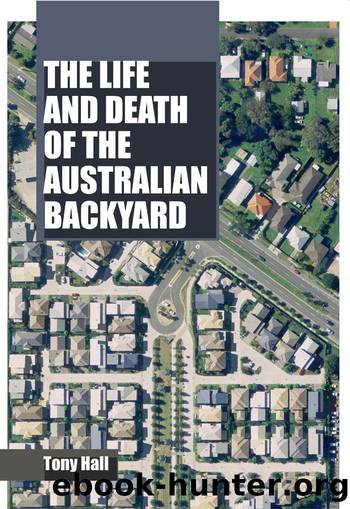The Life and Death of the Australian Backyard by Hall Tony;

Author:Hall, Tony;
Language: eng
Format: epub
Publisher: CSIRO Publishing
Commercial pressures for consolidation
Another âsuspectâ is the commercial pressure for more intensive development. The situation in the US is arguable more clear-cut than in Australia and has been rigorously described by Levine (2006). In the first phase of outer suburban development, landowning farmers and local councils are keen for land to be subdivided. They welcome the income provided and are reluctant to impose planning restrictions that might deter the developers. The low-density form keeps down costs and attracts middle-income buyers. However, as the new suburb matures, land values rise and higher densities become attractive to developers. This can result in pressure for building on infill sites, backland development, small apartment blocks on the sites of individual houses and the acquisition of a number of adjacent properties to comprehensively redevelop a larger site at higher density. However, the existing residents are usually vociferously opposed to such trends and, in response to these views, local councils introduce zoning ordinances that restrict move to higher densities.
The first part of this process can be seen at work in Australian cities, as shown in Chapter 3. There is also evidence for the existence of public opposition to suburban intensification. In Sydney, for example, the infill of the conventional suburb with âurbanâ forms has generated widespread opposition, whether it is situated close to the centre, in such suburbs as North Sydney or Woollahra, or on the suburban fringe, such as Blacktown or Campbelltown. This can lead to a situation where, during the phase of assessing medium-density proposals at local government level, the emphasis appears to be on the potential environmental impacts of the development on adjoining properties, as opposed to the implications of the development form for the end-user. However, as Miles Lewis has suggested in Suburban Backlash, objection to potential infill development by its neighbours runs far deeper than concern for physical impacts (Lewis 1999). He explains that, although, in some cases, the fight against higher density forms is mindless opposition to something unfamiliar, it is more an expression of resentment at the fact that irreversible alterations are taking place to areas and, by implication, to lifestyles that are cherished. In other words, the impacts of infill development are not just direct ones, such as increased traffic, overshadowing or privacy issues, but they also represent a violation to the collective memory of the low-density suburb and nostalgia for rus in urbe.
On the other hand, infill developments do occur, and they are often of low quality, such the notorious â6-packsâ. The â6-packâ results from replacing a single house within the curtilage of its original lot by the maximum number of units possible without the expense of going above two or three storeys. There is often no private outdoor amenity space whatsoever. Ironically, achievement of high net-densities is still restricted by the wide roads and front setbacks, which remain unchanged. The 6-pack is the product of a low level, if not non-existent, level of planning control.
If control is both interventionist and enlightened, comprehensive redevelopment of sites with well-designed schemes can result in the provision of private open space and good tree cover.
Download
This site does not store any files on its server. We only index and link to content provided by other sites. Please contact the content providers to delete copyright contents if any and email us, we'll remove relevant links or contents immediately.
| Arms Control | Diplomacy |
| Security | Trades & Tariffs |
| Treaties | African |
| Asian | Australian & Oceanian |
| Canadian | Caribbean & Latin American |
| European | Middle Eastern |
| Russian & Former Soviet Union |
The Secret History by Donna Tartt(16658)
The Social Justice Warrior Handbook by Lisa De Pasquale(11494)
Thirteen Reasons Why by Jay Asher(7801)
This Is How You Lose Her by Junot Diaz(5799)
Weapons of Math Destruction by Cathy O'Neil(5046)
Zero to One by Peter Thiel(4834)
The Myth of the Strong Leader by Archie Brown(4795)
Promise Me, Dad by Joe Biden(4455)
Beartown by Fredrik Backman(4433)
Stone's Rules by Roger Stone(4422)
How Democracies Die by Steven Levitsky & Daniel Ziblatt(4413)
The Fire Next Time by James Baldwin(4350)
100 Deadly Skills by Clint Emerson(4085)
A Higher Loyalty: Truth, Lies, and Leadership by James Comey(4039)
Rise and Kill First by Ronen Bergman(4020)
The David Icke Guide to the Global Conspiracy (and how to end it) by David Icke(3891)
The Farm by Tom Rob Smith(3878)
Secrecy World by Jake Bernstein(3788)
The Doomsday Machine by Daniel Ellsberg(3737)
